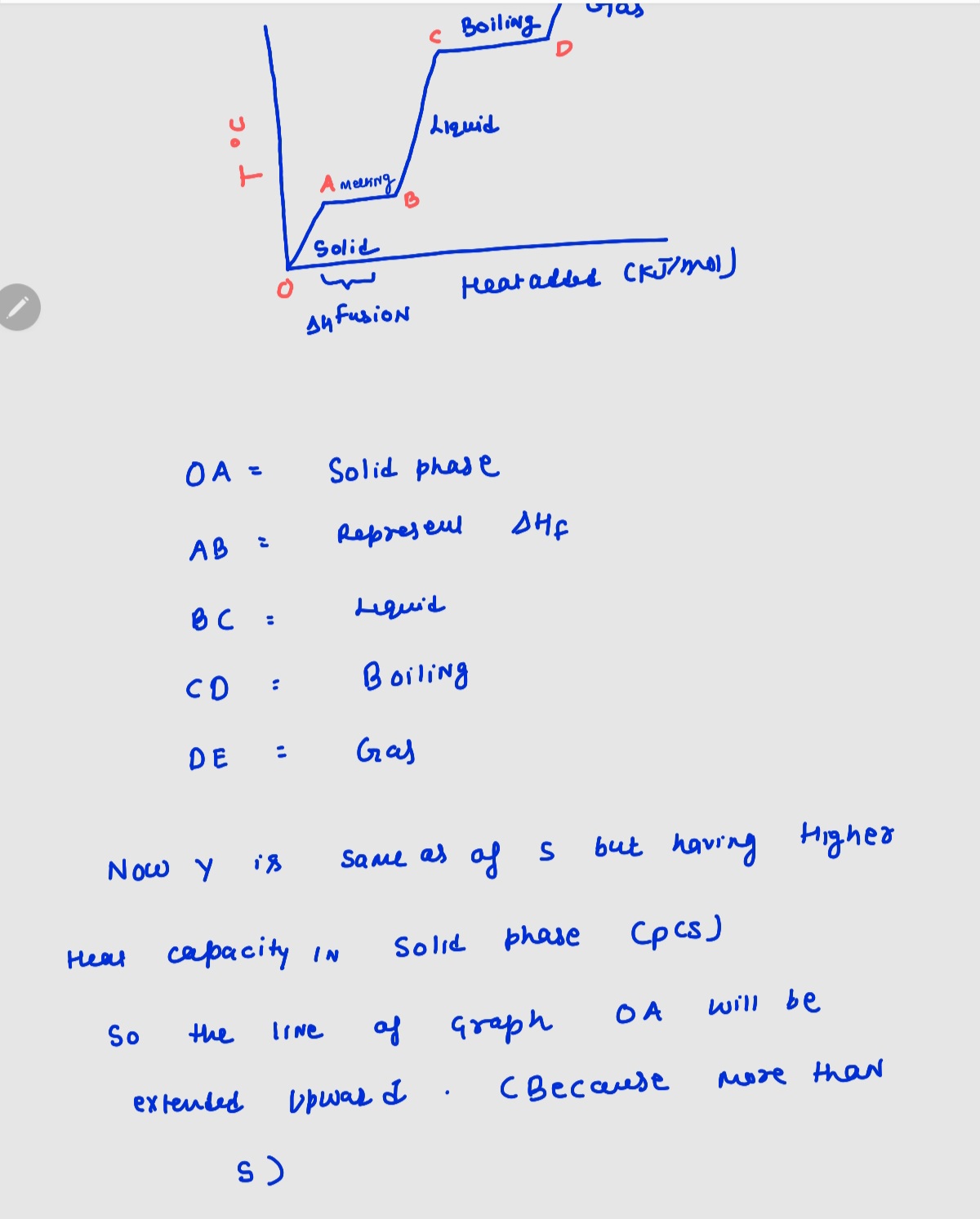A pure sample of Substance S is put into an evacuated flask. The flask is then heated steadily and the temperature measured as time passes. The results are graphed below, in the middle (in green). Identical experiments are now run on Substance Y and Substance Z. Substance Y is just like S except that it has a higher heat capacity in the solid phase Cp(s). Substance Z is just like S except that it has a lower enthalpy of fusion AH. Select the graphs below, on the left and right, that show the results you expect for these new experiments. Substance Y (higher C(s)) (Drag the slider to choose an image) ¡ temperature (°C) Substance S added heat (kJ/mol) Substance Z (lower ΔΗ.) (Drag the slider to choose an image) i 1
A pure sample of Substance S is put into an evacuated flask. The flask is then heated steadily and the temperature measured as time passes. The results are graphed below, in the middle (in green). Identical experiments are now run on Substance Y and Substance Z. Substance Y is just like S except that it has a higher heat capacity in the solid phase Cp(s). Substance Z is just like S except that it has a lower enthalpy of fusion AH. Select the graphs below, on the left and right, that show the results you expect for these new experiments. Substance Y (higher C(s)) (Drag the slider to choose an image) ¡ temperature (°C) Substance S added heat (kJ/mol) Substance Z (lower ΔΗ.) (Drag the slider to choose an image) i 1
Chemistry
10th Edition
ISBN:9781305957404
Author:Steven S. Zumdahl, Susan A. Zumdahl, Donald J. DeCoste
Publisher:Steven S. Zumdahl, Susan A. Zumdahl, Donald J. DeCoste
Chapter1: Chemical Foundations
Section: Chapter Questions
Problem 1RQ: Define and explain the differences between the following terms. a. law and theory b. theory and...
Related questions
Question

Transcribed Image Text:A pure sample of Substance S is put into an evacuated flask. The flask is then heated steadily and the temperature measured as time passes. The results are
graphed below, in the middle (in green).
Identical experiments are now run on Substance Y and Substance Z. Substance Y is just like S'except that it has a higher heat capacity in the solid phase C₂ (s).
Substance Z is just like S except that it has a lower enthalpy of fusion AH₁.
Select the graphs below, on the left and right, that show the results you expect for these new experiments.
Substance Y
(higher C(s))
(Drag the slider to
choose an image)
2
³
1
5
temperature (°C)
Substance S
added heat (kJ/mol)
Substance Z
(lower AH₂)
(Drag the slider to
choose an image)
21
3
Expert Solution
Step 1

Trending now
This is a popular solution!
Step by step
Solved in 2 steps with 2 images

Knowledge Booster
Learn more about
Need a deep-dive on the concept behind this application? Look no further. Learn more about this topic, chemistry and related others by exploring similar questions and additional content below.Recommended textbooks for you

Chemistry
Chemistry
ISBN:
9781305957404
Author:
Steven S. Zumdahl, Susan A. Zumdahl, Donald J. DeCoste
Publisher:
Cengage Learning

Chemistry
Chemistry
ISBN:
9781259911156
Author:
Raymond Chang Dr., Jason Overby Professor
Publisher:
McGraw-Hill Education

Principles of Instrumental Analysis
Chemistry
ISBN:
9781305577213
Author:
Douglas A. Skoog, F. James Holler, Stanley R. Crouch
Publisher:
Cengage Learning

Chemistry
Chemistry
ISBN:
9781305957404
Author:
Steven S. Zumdahl, Susan A. Zumdahl, Donald J. DeCoste
Publisher:
Cengage Learning

Chemistry
Chemistry
ISBN:
9781259911156
Author:
Raymond Chang Dr., Jason Overby Professor
Publisher:
McGraw-Hill Education

Principles of Instrumental Analysis
Chemistry
ISBN:
9781305577213
Author:
Douglas A. Skoog, F. James Holler, Stanley R. Crouch
Publisher:
Cengage Learning

Organic Chemistry
Chemistry
ISBN:
9780078021558
Author:
Janice Gorzynski Smith Dr.
Publisher:
McGraw-Hill Education

Chemistry: Principles and Reactions
Chemistry
ISBN:
9781305079373
Author:
William L. Masterton, Cecile N. Hurley
Publisher:
Cengage Learning

Elementary Principles of Chemical Processes, Bind…
Chemistry
ISBN:
9781118431221
Author:
Richard M. Felder, Ronald W. Rousseau, Lisa G. Bullard
Publisher:
WILEY